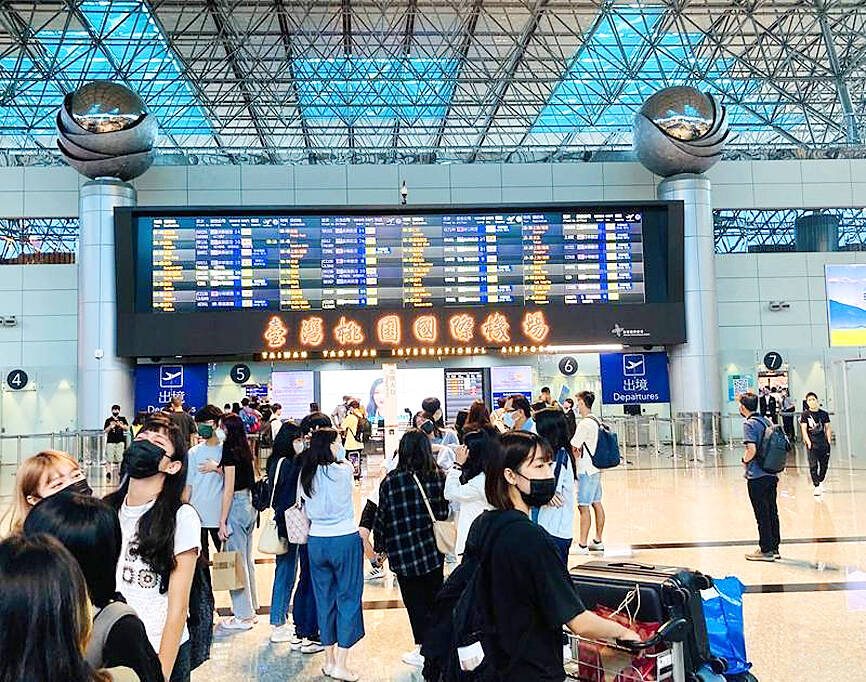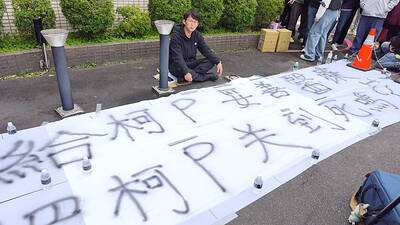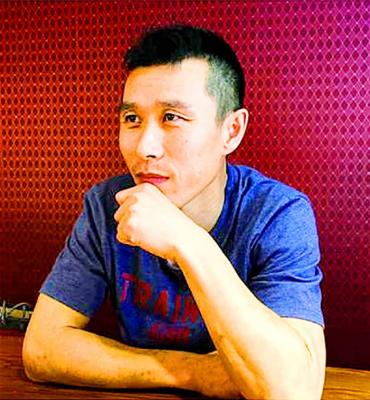The nation is expected to greet its 1 millionth international visitor of the first quarter at the end of this month, earlier than scheduled, the Tourism Bureau said.
The bureau had set a goal of attracting 820,000 international tourists during the first quarter, but it met that target faster than expected, International Affairs Division Director Huang Shih-fang (黃勢芳) said yesterday.
The Taiwan Lantern Festival and an intensive international tourism marketing campaign helped the bureau exceed its goal, bureau Deputy Director-General Trust Lin (林信任) said.

Photo: Chen Hsin-yu, Taipei Times
“We need to intensify our tourism marketing in Japan. Before the COVID-19 pandemic, Japan was our second-largest source of international tourists,” Lin said.
However, the return of Japanese tourists has not been significant, as Tokyo extended domestic travel subsidies from this month until the beginning of summer, he said.
South Korea has emerged as the largest source of international tourists so far this year, the bureau said, adding that Taiwan was already reporting a gradual increase in South Korean tourists before the COVID-19 pandemic.
From October last year to January, Taiwan has recorded 696,474 outbound tourists and 254,359 inbound visitors, bureau data showed.
Booking.com Taiwan area manager Regina Chan (詹雅?) said that most of the inbound travelers who arrived after Taiwan reopened its borders in the middle of last year came for business.
More international tourists want to visit Taiwan following international media coverage of Taiwan and changes in cross-strait relations, she said.
Taiwan can draw tourists from nations targeted by the New Southbound Policy and those from Europe and North American with more diverse tour arrangements, such as those focused on religion and natural scenery in Taiwan, she said.
In related news, the Travel Quality Assurance Association (TQAA) on Friday said that the cost of group tours from Taiwan to Asian destinations, including Japan and Southeast Asia, is expected to fall 10 to 20 percent in the second quarter compared with the previous quarter.
The travel agency trade group said that the depreciation of the yen and cuts in airline fares would lower group travel costs to Japanese cities.
Citing Tokyo and Osaka as the most popular destinations for Taiwanese, the association said it expected five-day tours to Osaka to cost NT$42,800 to NT$62,800 during the cherry blossom season next month and from NT$33,900 to NT$55,900 in May and June.
However, tour group costs to the US, Canada and Europe are expected to continue to rise in the April-to-June period, the TQAA said.
The sequential increase in costs to travel to the US and Canadian markets is expected to reach 30 to 40 percent in the quarter, reflecting higher transportation and lodging expenses amid rising airfares and bus costs, as well as a labor shortage.

The High Prosecutors’ Office yesterday withdrew an appeal against the acquittal of a former bank manager 22 years after his death, marking Taiwan’s first instance of prosecutors rendering posthumous justice to a wrongfully convicted defendant. Chu Ching-en (諸慶恩) — formerly a manager at the Taipei branch of BNP Paribas — was in 1999 accused by Weng Mao-chung (翁茂鍾), then-president of Chia Her Industrial Co, of forging a request for a fixed deposit of US$10 million by I-Hwa Industrial Co, a subsidiary of Chia Her, which was used as collateral. Chu was ruled not guilty in the first trial, but was found guilty

DEADLOCK: As the commission is unable to forum a quorum to review license renewal applications, the channel operators are not at fault and can air past their license date The National Communications Commission (NCC) yesterday said that the Public Television Service (PTS) and 36 other television and radio broadcasters could continue airing, despite the commission’s inability to meet a quorum to review their license renewal applications. The licenses of PTS and the other channels are set to expire between this month and June. The National Communications Commission Organization Act (國家通訊傳播委員會組織法) stipulates that the commission must meet the mandated quorum of four to hold a valid meeting. The seven-member commission currently has only three commissioners. “We have informed the channel operators of the progress we have made in reviewing their license renewal applications, and

Taiwan People’s Party (TPP) Chairman Huang Kuo-chang (黃國昌) yesterday appealed to the authorities to release former Taipei mayor Ko Wen-je (柯文哲) from pretrial detention amid conflicting reports about his health. The TPP at a news conference on Thursday said that Ko should be released to a hospital for treatment, adding that he has blood in his urine and had spells of pain and nausea followed by vomiting over the past three months. Hsieh Yen-yau (謝炎堯), a retired professor of internal medicine and Ko’s former teacher, said that Ko’s symptoms aligned with gallstones, kidney inflammation and potentially dangerous heart conditions. Ko, charged with

Taiwan-based publisher Li Yanhe (李延賀) has been sentenced to three years in prison, fined 50,000 yuan (US$6,890) in personal assets and deprived political rights for one year for “inciting secession” in China, China's Taiwan Affairs Office spokesman Chen Binhua (陳斌華) said today. The Shanghai First Intermediate People’s Court announced the verdict on Feb. 17, Chen said. The trial was conducted lawfully, and in an open and fair manner, he said, adding that the verdict has since come into legal effect. The defendant reportedly admitted guilt and would appeal within the statutory appeal period, he said, adding that the defendant and his family have